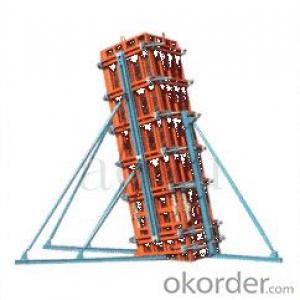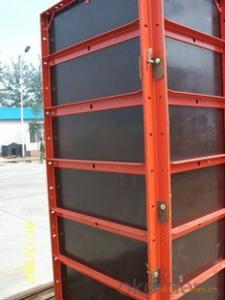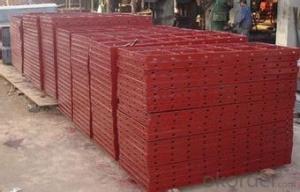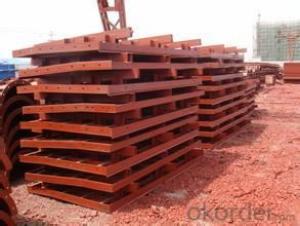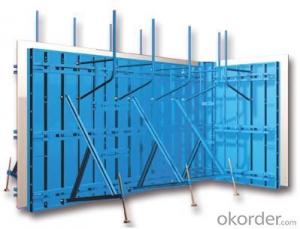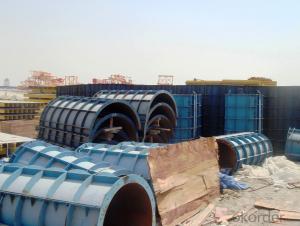Steel Frame Formworks with Different Kinds and Use for Construction
- Loading Port:
- Shanghai
- Payment Terms:
- TT or LC
- Min Order Qty:
- 1 m²
- Supply Capability:
- 100000 m²/month
OKorder Service Pledge
OKorder Financial Service
You Might Also Like
1. Structure of Steel Frame Formwork GK120 Description
There is a prizing part designed in the corner, which can help to position and remove formwork easily.The plywood is screwed on from the back when connecting frame and plywood, so the surface of the finished concrete is perfect.The formwork series are a complete system with a full set of accessories, and can be set up flexibly according to project demand.
2. Main Features of Steel Frame Formwork GK120
-convenient for construction
-easy to control the quality
-easy, rapid and economical.
3. Steel Frame Formwork GK120 Images
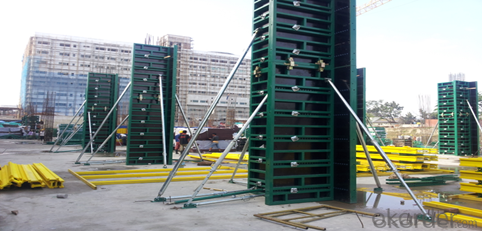
4. Steel Frame Formwork GK120Specifications
Steel Frame Formwork GK120 is used for the concrete pouring of square or rectangle column. The system has the same structure and similar connection type with wall formwork.
5.Steel Frame Formwork GK120
1) What can we do for you?
.We can ensure the quality of the Steel Frame Formwork GK120 and avoid extra expenses for customers.
.We can provide you the professional technical team.
.We can provide professional building proposal for your projects.
2) What promises can be done by us?
. If interested in this kind of formwork, please feel free to write us for any QUOTE.
. If need any technical and building assistance, we could provide on-site professional staff for instruction.
. Please DO check goods when courier knocks your door and contact us asap if any issueS.
3) What about of our after-sale services?
. Response will be carried out in 24hours after receiving any complain or request.
. Any formwork cost can be refund after order is confirmed.
. If the products are not based on the requirements, there will be the relevant compensations made for you.
4) What about the package and shipping time?
.Packing: wood package and adhesive tape
.Shipping: by sea
Shipping time: Normally small orders, it just1week business days to arrive your hand; When comes to the customs declaration, it may need 2weeks.
- Q:How does steel frame formwork handle different types of concrete admixtures?
- Steel frame formwork is a versatile and durable method for constructing concrete structures, and it can easily handle different types of concrete admixtures. Concrete admixtures are substances that are added to the concrete mix to enhance certain properties or characteristics of the final product. These admixtures can include accelerators, retarders, plasticizers, superplasticizers, air-entraining agents, and many others. Steel frame formwork provides a strong and rigid structure that can withstand the pressure and forces exerted by the concrete mix, regardless of the type of admixture used. The formwork system consists of steel panels, usually with plywood facing, that are connected together with strong and reliable locking mechanisms. This ensures that the formwork remains stable and secure during the pouring and curing process. When it comes to different types of concrete admixtures, steel frame formwork can easily accommodate them. For example, if an accelerator is added to the concrete mix to speed up the curing time, the steel frame formwork can handle the increased early strength development without any issues. Similarly, if a retarder is used to slow down the setting time, the formwork can provide the necessary support and stability during the extended curing period. Steel frame formwork is also compatible with plasticizers and superplasticizers, which are admixtures that improve the workability and flowability of the concrete mix. These admixtures increase the fluidity of the concrete, allowing it to easily flow and fill the formwork. The steel frame provides the necessary strength and rigidity to contain the highly fluid concrete mix and prevent any leakage or deformation. Furthermore, steel frame formwork can also handle air-entraining agents, which are admixtures that introduce tiny air bubbles into the concrete mix. These air bubbles improve the freeze-thaw resistance of the concrete and enhance its durability. The steel frame formwork ensures that the air-entrained concrete remains intact and properly consolidated during the pouring and curing process. In summary, steel frame formwork is well-equipped to handle different types of concrete admixtures. Its strength, stability, and compatibility with various admixtures make it a reliable choice for constructing concrete structures with enhanced properties and characteristics.
- Q:Can steel frame formwork be used for both horizontal and vertical structures?
- Steel frame formwork is a versatile and durable system widely employed in construction projects for various applications, supporting both horizontal and vertical structures. Comprising interconnected steel panels or frames, it creates a solid and rigid structure. For horizontal structures, like slabs, steel frame formwork plays a crucial role in supporting and containing the curing concrete. By easily adjusting and leveling the steel frames, the desired thickness and flatness of the concrete slab can be achieved. Furthermore, the steel formwork's easy removal and reassembly make it well-suited for repetitive construction processes. Similarly, steel frame formwork is also suitable for vertical structures such as walls and columns. Assembling and securing the steel frames in place allows for the creation of the desired shape and dimensions of the structure. The formwork can be designed to accommodate various architectural features and finishes, enabling design flexibility. Overall, steel frame formwork offers numerous advantages for both horizontal and vertical structures. It provides strength and stability, proves reusable and cost-effective, and facilitates efficient construction processes. Hence, it is a commonly adopted solution for both horizontal and vertical applications in construction projects.
- Q:How does steel frame formwork ensure accurate dimensions and alignment of concrete structures?
- Steel frame formwork is a popular method used in construction to ensure accurate dimensions and alignment of concrete structures. It consists of a rigid steel frame that is designed and manufactured to the specific dimensions of the structure being built. One of the key ways steel frame formwork ensures accurate dimensions is through its precise fabrication process. The steel frame is manufactured to tight tolerances, ensuring that it is dimensionally accurate and consistent. This means that when the formwork is installed, it will provide a precise and uniform shape for the concrete to be poured into. Additionally, steel frame formwork is designed to be rigid and strong, which helps to maintain the alignment of the concrete structure. The frame is typically braced and supported in such a way that it resists any movement or deformation during the pouring and curing of the concrete. This prevents any shifting or misalignment of the formwork, which could result in inaccurate dimensions and compromised structural integrity. Furthermore, steel frame formwork often includes adjustable features that allow for fine-tuning and precise adjustments. For example, adjustable props or brackets can be used to ensure that the formwork is level and plumb, further enhancing the accuracy of the dimensions and alignment of the concrete structure. Overall, the use of steel frame formwork provides a reliable and effective method for achieving accurate dimensions and alignment in concrete structures. Its precise fabrication, rigidity, and adjustable features all contribute to ensuring that the final product meets the desired specifications and standards.
- Q:How does steel frame formwork affect the overall maintenance requirements of a structure?
- Steel frame formwork can have a significant impact on the overall maintenance requirements of a structure. Firstly, the use of steel frame formwork provides a durable and robust support system for concrete during the construction process. This ensures that the structure is built to the highest standards, reducing the likelihood of maintenance issues arising from poor construction techniques. Additionally, steel frame formwork is designed to be reusable, which can greatly reduce the maintenance requirements of a structure over its lifespan. Unlike traditional timber formwork, steel frames are less prone to damage, warping, or rotting. This means that they can be easily cleaned, repaired, and reused for multiple construction projects, resulting in cost savings and reduced waste. Furthermore, the use of steel frame formwork allows for faster construction times, which can also contribute to lower maintenance requirements. With shorter construction periods, there is less exposure to adverse weather conditions and potential damage. This can help to minimize the need for maintenance and repairs in the long run. Moreover, the strength and stability provided by steel frame formwork can enhance the structural integrity of the building, reducing the risk of structural failures or issues that may require ongoing maintenance. This ensures that the structure remains safe and secure for its occupants. In conclusion, steel frame formwork can positively impact the overall maintenance requirements of a structure by providing a durable, reusable, and efficient construction method. By reducing the potential for construction-related issues and improving structural integrity, steel frame formwork can help minimize the need for ongoing maintenance, resulting in a more cost-effective and sustainable solution.
- Q:Are there any specific considerations for using steel frame formwork in industrial construction projects?
- Yes, there are several specific considerations for using steel frame formwork in industrial construction projects. Firstly, steel frame formwork offers high strength and durability, making it suitable for large-scale and heavy-duty applications commonly found in industrial projects. Additionally, steel formwork provides excellent dimensional accuracy, ensuring precise and consistent results. It is also fire resistant, which is crucial in industrial settings where fire safety is a priority. Furthermore, steel formwork is reusable, reducing overall project costs and environmental impact. However, it is important to note that steel formwork requires skilled labor and proper maintenance to ensure its longevity and optimal performance.
- Q:What are the different types of alignment devices used with steel frame formwork?
- The different types of alignment devices used with steel frame formwork are adjustable formwork clamps, alignment wedges, formwork pins, and formwork braces. These devices help ensure accurate and precise alignment of the formwork components during construction.
- Q:How does steel frame formwork ensure the proper alignment and positioning of form ties?
- Steel frame formwork ensures the proper alignment and positioning of form ties through its rigid and sturdy structure. The steel frame acts as a guide and support system for the form ties, ensuring that they are securely held in place during the concrete pouring process. The steel frame is designed with precision and accuracy, with predetermined positions for the form ties. These positions are typically marked or pre-drilled on the steel frame, allowing for easy and consistent placement of the form ties. When the form ties are inserted into the pre-determined positions of the steel frame, they are held securely in place by the frame's strong clamping mechanism. This clamping mechanism prevents any movement or displacement of the form ties during the concrete pouring process. Furthermore, the rigid nature of the steel frame ensures that it remains stable and maintains its shape even under the pressure exerted by the wet concrete. This stability is crucial for the proper alignment and positioning of the form ties, as any misalignment or movement can result in uneven concrete surfaces or structural weaknesses. Overall, steel frame formwork provides a reliable and efficient solution for ensuring the proper alignment and positioning of form ties. Its robust and stable structure, along with its predetermined positions and secure clamping mechanism, guarantees accurate and consistent form tie placement, resulting in high-quality concrete structures.
- Q:What are the different types of lifting and handling equipment used with steel frame formwork?
- Construction projects commonly utilize various types of lifting and handling equipment in conjunction with steel frame formwork. These equipment are designed to streamline the process of assembly and disassembly, making it more efficient and less labor-intensive. 1. Cranes, including tower cranes, mobile cranes, and crawler cranes, are frequently employed in construction as a primary lifting equipment. They possess the capability to handle heavy loads and are often used for transporting and positioning steel frame formwork components on-site. 2. Forklifts are another commonly utilized equipment for handling steel frame formwork. They are purpose-built for lifting and carrying heavy loads, and their adjustable forks allow for precise placement and movement of formwork components. 3. Hoists are mechanical devices primarily used for vertical lifting and lowering of loads. They find frequent application in lifting smaller steel frame formwork components, such as beams and panels, to specific heights. Hoists are available in electric, manual, and air-powered configurations to accommodate project requirements. 4. Scaffolding, a temporary structure supporting workers and materials during construction, can also be utilized for lifting and handling steel frame formwork components. Scaffolding systems often incorporate pulleys and ropes for hoisting and positioning formwork components in place. 5. Jib cranes, smaller and more compact than traditional cranes, are typically mounted on walls or columns. They are particularly suitable for use in confined spaces or areas with limited access, where larger cranes may not be feasible. Jib cranes provide precise and effortless lifting and handling of smaller steel frame formwork components. 6. Trolleys and rollers aid in the movement of steel frame formwork components across the construction site. They facilitate the transportation and positioning of formwork components, ensuring a smooth and efficient assembly or disassembly process. In summary, the variety of lifting and handling equipment utilized with steel frame formwork equips construction workers with the necessary tools to manipulate and position components safely and effectively. These equipment not only save time and effort but also contribute to the seamless progress of construction projects.
- Q:Can steel frame formwork be used in areas with limited space for storage?
- Indeed, areas with limited storage space can utilize steel frame formwork. Its versatility and compactness are well-known, rendering it appropriate for projects with restricted storage capacity. Unlike conventional formwork systems, steel frame formwork can be effortlessly disassembled and reassembled, enabling efficient utilization of storage space. Furthermore, its lightweight nature and ease of transportation enhance its suitability for areas with limited storage capability. In summary, steel frame formwork proves to be a pragmatic and flexible solution for construction projects in confined spaces.
- Q:How does steel frame formwork affect the overall aesthetics of a structure?
- Steel frame formwork can have a significant impact on the overall aesthetics of a structure. One of the main advantages of using steel frame formwork is its ability to create clean and smooth surfaces. The steel frames are designed to hold the concrete in place during the pouring process, ensuring that the finished structure has straight lines and sharp corners. Unlike traditional formwork materials such as wood, steel frame formwork does not warp or bend under the weight of the concrete. This results in a more uniform and visually appealing finish, as there are no visible imperfections caused by uneven formwork. Additionally, steel frame formwork allows for greater flexibility in design. The frames can be easily adjusted and modified to accommodate complex shapes and intricate details, giving architects and designers more freedom to create unique and visually striking structures. This versatility is especially important in modern architecture, where aesthetics play a crucial role. Moreover, the use of steel frame formwork can also have a positive impact on the durability and longevity of a structure. Steel is a highly robust material that can withstand harsh weather conditions and resist corrosion, ensuring that the formwork will maintain its structural integrity over time. This durability contributes to the overall aesthetics of the structure, as it allows for a long-lasting and visually pleasing appearance. In conclusion, steel frame formwork enhances the overall aesthetics of a structure by providing clean and smooth surfaces, allowing for greater design flexibility, and ensuring durability and longevity. Its ability to create visually appealing finishes and maintain structural integrity makes it a preferred choice for architects and designers seeking to achieve aesthetically pleasing results.
1. Manufacturer Overview |
|
|---|---|
| Location | |
| Year Established | |
| Annual Output Value | |
| Main Markets | |
| Company Certifications | |
2. Manufacturer Certificates |
|
|---|---|
| a) Certification Name | |
| Range | |
| Reference | |
| Validity Period | |
3. Manufacturer Capability |
|
|---|---|
| a)Trade Capacity | |
| Nearest Port | |
| Export Percentage | |
| No.of Employees in Trade Department | |
| Language Spoken: | |
| b)Factory Information | |
| Factory Size: | |
| No. of Production Lines | |
| Contract Manufacturing | |
| Product Price Range | |
Send your message to us
Steel Frame Formworks with Different Kinds and Use for Construction
- Loading Port:
- Shanghai
- Payment Terms:
- TT or LC
- Min Order Qty:
- 1 m²
- Supply Capability:
- 100000 m²/month
OKorder Service Pledge
OKorder Financial Service
Similar products
New products
Hot products
